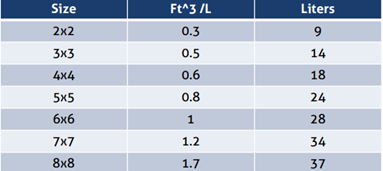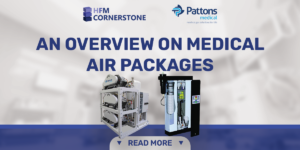Sizing criteria is based on what gas you’re using, so this is not going to be an exact calculation. The rule of thumb for is to try to size one bank to be about one to two weeks off. This is because it is easier to get deliveries within that timeframe. If you are in a rural area, you can go larger if you want to so that you only need to change it out once a month. You can find manifold sizing guidelines on the Pattons Medical website.
OXYGEN MANIFOLD
For an oxygen manifold, Pattons Medical recommends you count the number of beds in the facility and the number of beds that are in sizing, they can overlap. We see that range falling anywhere between 400 to a thousand cubic feet, a bed per month.
If you’re sizing it for an acute care hospital that has an ICU or NICU, stay in that thousand range. Keep yourself covered that you’re using the max oxygen on a monthly basis. If you have an ambulatory surgery center or an outpatient, that’s not 24 hours, but when they use it eight hours a day, they’re using a lot of it. Put yourself in the middle of that range, at around 600. If you have a free-standing ER or behavioral health where they have oxygen outlets, but most times, you’re not hooking anybody up to it, stay at around 400. When you get your result, you divide it by four, and that gives you your weekly usage.
NITROUS OXIDE
For nitrous oxide, Pattons Medical recommends counting up all the anesthetizing locations that are piped with nitrous oxide if they’re bringing nitrous in on an anesthesia cart. Do not count if they are small “E” cylinders and cannot be used in the manifold. The standard sizing method assumes one cylinder per anesthetizing location. In all, a two-by-two manifold serves one to four operating rooms, a four-by-four manifold serves five to eight.
MEDICAL AIR MANIFOLDS
If you have a small facility and you’re not sure if you need a medical air compressor, a medical air manifold will work. It isn’t a ton of air and will fit within your budget. First, you would need to do an actual medical air calculation like you would for a compressor. This can be found on the Pattons Medical website.
A two-horsepower scroll is the smallest. It has to be a small application for the compressor not to work.
Multiple your scfm by 24.317 to get your liters. This chart can be used to figure out what size medical air manifold would work for your facility. Pattons Medical recommends not using a manifold unless you are at 3 scfm or lower, possibly in a very small application. Though, if you are using a ventilator, a manifold will not make sense.

EXOTIC MANIFOLDS
You will also need to understand how to size exotic manifolds such as heliox or argon, which can be blended with oxygen, helium, and carbon dioxide. It is very important to obtain information from the clinical staff on the usage required by the equipment delivering the gas.
For example, Heliox is primarily used in NICU or maternity ward settings and the usage factor is very low. In the overwhelming majority of the applications, a 2×2 is adequate for the 2-week usage and then some.
NITROGEN OR INSTRUMENT AIR MANIFOLDS
Nitrogen and instrument air are interchangeable, so you shouldn’t need both in any facility. A standard ortho operating room uses about eight scfm, and a thoracic operating room uses 15 scfm. Most regulators for these allow 70 scfm to flow so that all the ORs can operate simultaneously. An H cylinder contains 230 cubic feet. If you have one to two operating rooms, use a four by four instrument error.
HIGH PRESSURE RESERVES FOR LIQUID
If you have a liquid-by-liquid manifold, you need to have a high-pressure reserve. The high-pressure reserve must be sized to handle your 24-hour demand. The amount used on a monthly basis is divided by 30 to get the daily demand, then you divide that number by the contents of the H cylinder for that gas.




